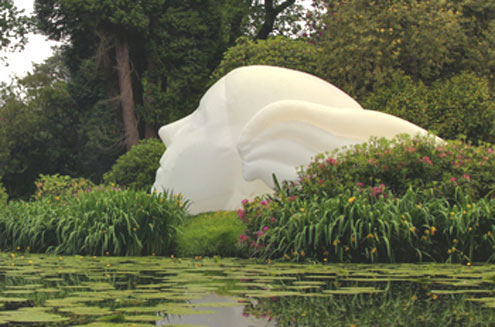Blown away!
Tue, 24 Jul 2012 15:09:00 BST
Lecturer Anneké Pettican and the inflatable artwork that intrigues thousands

Trine Messenger - photo courtesy of Chris Jones
THOUSANDS of visitors to the Tatton Park Biennial, in the grounds of the Cheshire stately home, have been fascinated by one of the most striking works on display at the prestigious, international outdoor art exhibition, ‘Flights of Fancy’.
‘Trine Messenger’ (pictured), a giant female head, seven metres long, is an inflatable structure that appears to have landed on the banks of the Japanese island. The impressive and innovative art work is the co-creation of University of Huddersfield senior lecturer Anneké Pettican (pictured below) and her two colleagues, Chara Lewis and Kristin Mojsiewicz, known collectively as Brass Art.
There are intriguing dimensions to Trine Messenger. For example, the face is actually an amalgam of the features of its three creators. They have worked together since 1999 and they introduce many disciplines and techniques to the creative mix. These range from traditional painting and drawing to film making, installations, performance and the very latest digital technology.
In order to produce the amalgamated face for Trine Messenger, the three women had their features recorded using 4-D biomedical scanning. The images were then combined and converted into 3-D point cloud data. This was then simplified and translated into a 2-D pattern that would create the giant 3-D inflatable artwork.
“We were trying to create an uncanny likeness, so you look at the object and see the three of us in it,” explained Anneké, who lectures in digital media at the University of Huddersfield. Her Brass Art colleagues also teach in higher education.

The trio – who have exhibited widely – were commissioned to produce a work for the Tatton Park Biennial by its curators, Danielle Arnaud and Jordan Kaplan, leading figures in the art world.
Trine Messenger is intriguing in one other respect. As the Biennial closes for the night, Trine Messenger literally deflates and sinks from view. The next morning, solar-powered batteries and timers make it rise again, ready for the day’s first visitors.
The artwork is made from the fabric used for hot air balloons. It is an extremely large piece, but when deflated it can be packed neatly into a bag and is therefore highly portable.
The automated deflation-inflation cycle, which happens every night and every morning during the Biennial’s run from June to late September, has proved to be a popular piece of performance art in its own right.
Brass Art will raise their international profile further when they attend the annual conference SIGGRAPH (Special Interest Group on Graphics and Interactive Techniques), taking place in Los Angeles. The trio will deliver a paper examining the ‘Creation of Shadow Worlds’, which describes two other intriguing projects that employ digital technology
The first is their installation Still Life No.1 which formed part of the ‘Dark Matters’ exhibition at the Whitworth Art Gallery and attracted over 57,000 visitors. The piece developed their ongoing research into 3-D body scanning and printing technologies, working with Manchester Museum’s mineralogy collection. The second introduces their new work ‘Shadow World: Writers’ Rooms’ – the first in a projected series of works – which used the Brönte Parsonage Museum in Haworth as a site for a sequence of improvised performances that were photographed and filmed using the new X-Box Kinect. The resulting shadow-play material will eventually form the basis of a new exhibition.
“It is about us inhabiting a space – in this case where the Brönte sisters and their brother were – and allowing that to direct and inform how we created a shadow play,” said Anneké. “We weren’t acting out the lives of the Bröntes, but responding to a resonant and loaded space.”
The Tatton Park Biennial runs until 30 September 2012.







